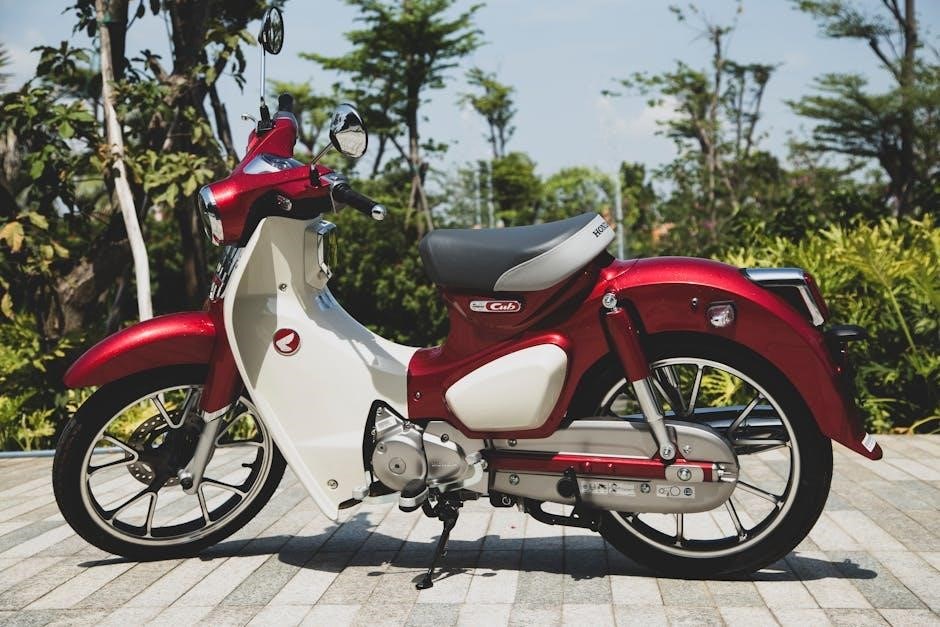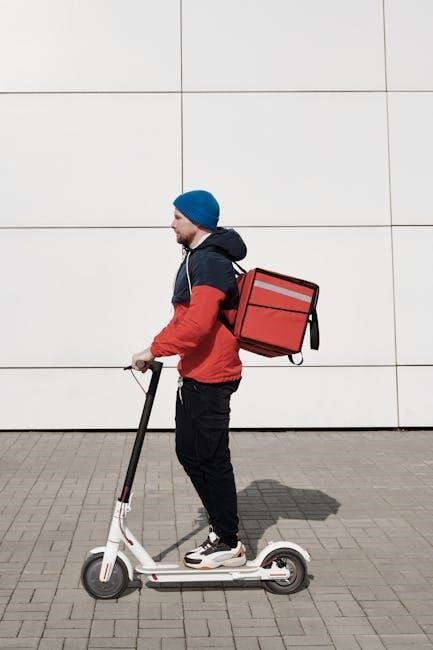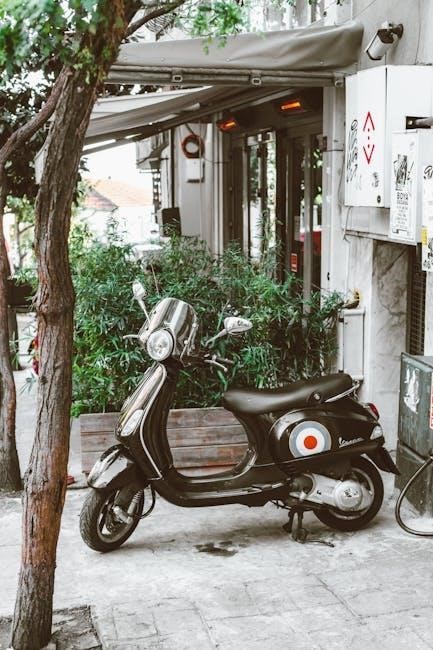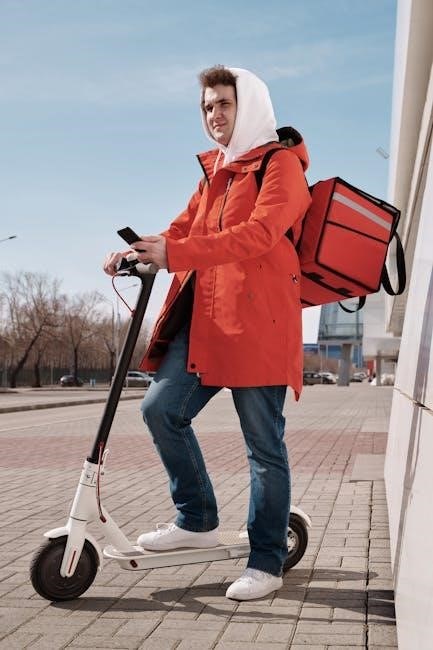mobility scooter troubleshooting guide
Understanding Your Mobility Scooter

Regularly inspect your scooter’s tires‚ brakes‚ and battery. Ensure proper charging and avoid overloading. Address beeping alarms promptly‚ as they indicate issues like low battery or obstructions. Always follow the manufacturer’s guidelines for maintenance and usage to ensure optimal performance and safety.

- Check tire pressure and brakes frequently.
- Charge batteries as recommended.
- Monitor weight limits to prevent strain.
- Investigate beeping alarms immediately.
By addressing these areas‚ you can troubleshoot common issues and maintain your scooter’s reliability.
Battery Care and Maintenance
Proper battery care is essential for your mobility scooter’s performance. Most scooters use lead-acid batteries‚ which require regular charging. Aim to charge your battery for at least 8-10 hours or overnight‚ as they have built-in regulators to prevent overcharging. Avoid deep discharges‚ as this can reduce battery lifespan. Always follow the manufacturer’s charging instructions and ensure the charger is compatible with your scooter’s voltage. Clean the terminals regularly to prevent corrosion and check for loose connections. Store the scooter in a cool‚ dry place when not in use. If you notice irregular charging or power loss‚ inspect the battery or consult a professional. Proper maintenance will extend the life of your battery and ensure reliable operation.
- Charge batteries for 8-10 hours or overnight.
- Avoid deep discharges to prolong battery life.
- Clean terminals to prevent corrosion.
- Store in a cool‚ dry place when not in use.
Weight Limits and Safe Usage
Adhering to your mobility scooter’s weight limit is crucial for safety and performance. Exceeding the recommended weight can cause instability‚ reduced efficiency‚ or even damage to the scooter. Always check the manufacturer’s guidelines to ensure you are within the specified limit. Avoid carrying additional items that could add unnecessary weight. Distribute your weight evenly while riding to maintain balance and stability. If you notice the scooter struggling to move or making unusual noises‚ it may indicate overloading. Regularly inspect the scooter’s condition to ensure it can handle your weight safely. Proper usage within weight limits will enhance your safety and extend the scooter’s lifespan.
- Check the manufacturer’s weight limit in the manual.
- Avoid overloading with extra items.
- Distribute weight evenly for stability.
- Inspect the scooter regularly for damage.
Common Issues and Solutions
Address beeping alarms by checking battery levels or obstructions. If your scooter breaks down‚ ensure it’s on a flat surface and consult the manual for troubleshooting steps.
- Check battery charge and connections.
- Inspect for blockages or obstructions.
- Refer to the user manual for guidance.
Why Your Mobility Scooter Might Be Beeping

Your mobility scooter may beep due to low battery levels‚ obstructions‚ or exceeding weight limits. Check the battery charge and ensure it’s properly connected. Clear any blockages around sensors or wheels. If the issue persists‚ consult the user manual for specific error codes. Addressing these promptly prevents further complications and ensures smooth operation.
- Low battery or faulty connections.
- Obstructions near sensors or wheels.
- Exceeding weight limits.
Always refer to the manual for model-specific solutions.

What to Do If Your Scooter Breaks Down
If your mobility scooter breaks down‚ remain calm and assess the situation. Check for obvious issues like a flat tire‚ loose connections‚ or a dead battery. If the battery is drained‚ charge it for at least 8-10 hours. Ensure no obstructions block the wheels or sensors. If the scooter still doesn’t work‚ consult the user manual for troubleshooting steps. For complex problems‚ contact the manufacturer or a professional technician. Always keep emergency contact information handy and consider carrying a backup power source or mobility aid.
- Check for simple fixes like tire pressure or battery charge.
- Consult the user manual for troubleshooting guidance.
- Contact a professional if issues persist.
Stay prepared with backup options to ensure safety and mobility.
Legal and Safety Considerations
Mobility scooters are classified as invalid carriages‚ exempt from drink-driving laws. Always follow traffic rules and safety guidelines. Be aware of weight limits and local regulations.
- Know your scooter’s legal classification.
- Adhere to traffic and safety rules.
- Check local regulations for usage.

Mobility Scooter Laws and Regulations
Mobility scooters are classified as invalid carriages under UK law‚ exempting them from traditional drink-driving rules. They are designed for individuals with mobility challenges and must be used responsibly. Users must adhere to specific regulations‚ such as operating on pavements or roads where permitted. Weight limits and safety guidelines must be followed to ensure legal compliance. Be aware of local laws‚ as rules may vary by region. Always consult local authorities for specific regulations in your area.
- Classified as invalid carriages in the UK.
- Exempt from drink-driving laws.
- Adhere to pavement and road usage rules.
- Follow weight limits and safety guidelines.
Understanding these regulations ensures safe and legal operation of your mobility scooter.
Safety Tips for Operating Your Scooter

Always prioritize safety when operating your mobility scooter. Ensure you are visible to others by using lights‚ reflective clothing‚ and horns. Avoid speeding and maintain a safe distance from pedestrians and vehicles. Regularly inspect your scooter’s tires‚ brakes‚ and battery to ensure proper function. Be cautious on uneven terrain and avoid curbs higher than your scooter’s clearance. Never operate your scooter under the influence of alcohol or drugs. Stay alert and follow traffic rules to minimize risks; By adhering to these guidelines‚ you can enjoy safe and confident mobility.
- Use lights and reflective clothing for visibility.
- Avoid speeding and maintain a safe distance.
- Inspect tires‚ brakes‚ and battery regularly.
- Be cautious on uneven terrain and curbs.
- Avoid operating under the influence of substances.
Safe operation ensures a better experience for both you and others around you.

Maintenance and Troubleshooting
Regularly inspect tires‚ brakes‚ and batteries. Clean and lubricate moving parts. Address error beeps or movement issues promptly by checking connections and error codes. Ensure proper maintenance to prevent breakdowns and extend scooter lifespan.
Regular Maintenance Checks
Regular maintenance is crucial to ensure your mobility scooter operates efficiently. Start by inspecting the tires for wear and proper inflation‚ as underinflated tires can reduce maneuverability and safety. Next‚ check the brakes to ensure they function smoothly and reliably. The battery is another key component; charge it for at least 8-10 hours after each use to maintain its health. Additionally‚ lubricate the axles and moving parts to prevent friction and wear. Always review the owner’s manual for specific maintenance schedules tailored to your model. By performing these checks regularly‚ you can extend the lifespan of your scooter and prevent unexpected breakdowns.
Troubleshooting Common Mechanical Problems
Identifying and addressing mechanical issues promptly ensures your mobility scooter runs smoothly. If the motor stalls‚ check for loose connections or worn brushes. Brake problems may arise from misaligned calipers or worn pads; adjust or replace them as needed. Steering issues often result from misaligned wheels or uneven tire pressure. For jerky movements‚ inspect the drive belt for wear or fraying. Always refer to your owner’s manual for specific troubleshooting steps. If problems persist‚ consult a professional technician to avoid further damage.
- Check motor connections and brushes for wear.
- Adjust brakes or replace pads if necessary.
- Ensure even tire pressure and proper alignment.
Addressing these mechanical issues early prevents costly repairs and ensures safe operation.

Repair and Replacement Options
For complex repairs‚ consult a professional technician. Check warranty coverage for parts and labor. Consider replacing worn or damaged components with genuine manufacturer-approved parts for optimal performance.
- Seek expert help for major mechanical issues.
- Verify warranty terms for repairs and replacements.
- Use authentic parts to maintain scooter reliability.
When to Seek Professional Repair
If your mobility scooter experiences complex mechanical or electrical issues‚ it’s important to seek professional repair. This includes problems with the motor‚ gearbox‚ or electrical components. DIY repairs can often lead to further damage or safety hazards. Always consult a certified technician if you’re unsure about the issue or lack the tools and expertise to fix it. Additionally‚ if the scooter is under warranty‚ professional repair may be required to maintain coverage. Regular maintenance can prevent many issues‚ but when problems arise‚ trusting a professional ensures your scooter remains safe and functional. They will use genuine parts and adhere to manufacturer guidelines‚ ensuring reliability and extending the scooter’s lifespan.
